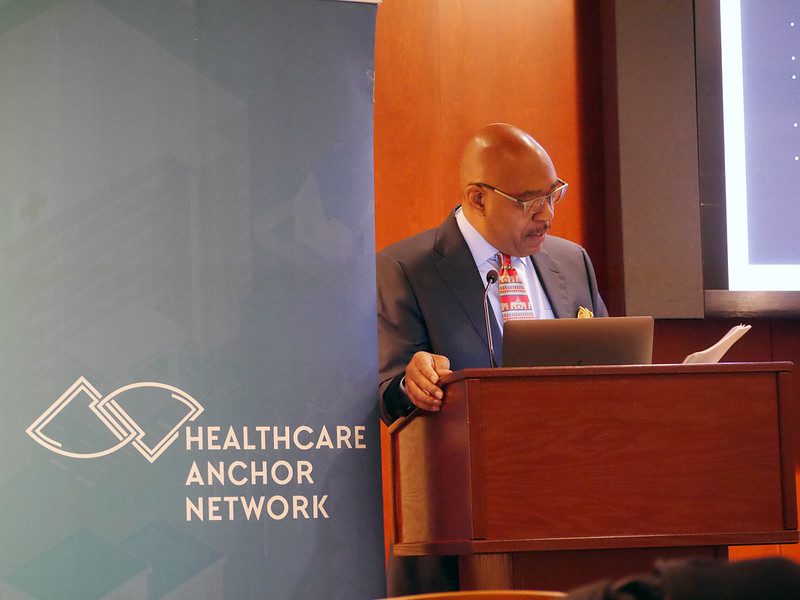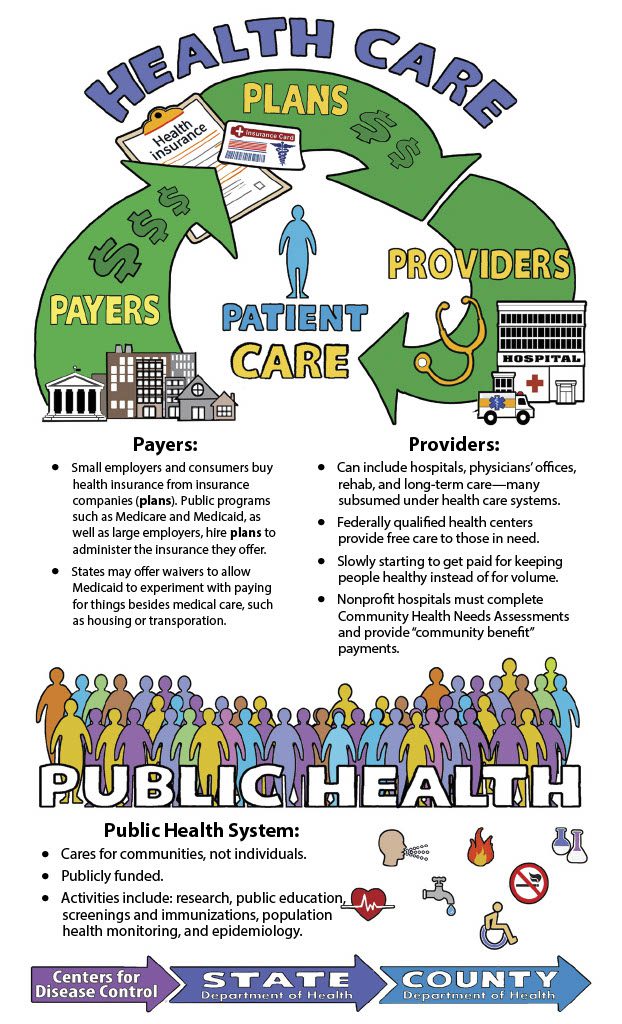This article is part of the Under the Lens series
In the first part of this series, we took a look at public health departments, why it’s crucial for public health practitioners to focus on power and racism if they want to build health equity, and some of the motivations public health departments have for partnering with community organizers.
Health departments offer resources related to research capacity and data, and some fund community organizations directly. They can also act as conveners, providing connections to other government agencies or neutral ground for building alliances. There are plenty of examples of what health departments bring to partnerships to build community power and advance health equity. They can:
Conduct research and strategic planning to shift policy and framing—Working with health departments on research can provide powerful health analysis and framing for issues that your organization is working on. The Alameda County Public Health Department in California co-produced two major research projects with housing and racial justice organization Causa Justa::Just Cause that received extensive media coverage and helped drive policy changes. Rebuilding Neighborhoods, Restoring Health was one of the first reports in the country to discuss foreclosure as a health issue, while Development without Displacement focused on the health impacts of residential displacement and local policy responses. The research combined quantitative data collected by the health department with extensive focus group and interview data from people living in the neighborhoods most affected by foreclosure and displacement.
With their relationship solidified through these projects, the department continues to use its research capacity to provide objective health analysis in public testimony supporting stronger tenant protections. They’ve also changed internal practices: the department’s asthma program collaborated with code enforcement officers to identify landlords and hold them accountable for poor housing conditions that trigger asthma attacks, and “healthy home” visits now include questions about rent increases.
Use their regulatory authority—Departments have direct regulatory oversight over some issues, and community partnerships (and pressure!) can encourage them to use their authority creatively. The San Francisco Department of Public Health’s Environmental Health Branch partnered with the Chinese Progressive Association on a participatory research project about working conditions in Chinatown restaurants. The resulting report documented the prevalence of wage theft, and the Environmental Health Branch moved to incorporate compliance with labor standards into their restaurant health permitting process. One labor enforcement agency noted that restaurant owners were much more responsive to the threat of a suspended health permit than they were to labor violation fines.
In the context of COVID-19, public health departments have additional authority granted under emergency orders, and have an important responsibility not just to put it to use around issues like workplace safety, but also to ensure equitable enforcement.
Access and analyze data—Health departments analyze and publish tons of quantitative data for planning purposes, and increasingly they draw on information from many sectors. This data can be a great tool for community organizations to show how resources are distributed and to connect the issues they’re working on to health.
The Healthy Chicago 2025 Data Compendium doesn’t just include statistics about life expectancy and smoking rates—it has data on air quality, gentrification, use of housing choice vouchers, access to paid leave, and much more. Most of the data is broken down by race and neighborhood, and helps make the case for one of four priorities in the department’s five-year plan: “Transform policies and processes to foster anti-racist, multicultural systems.” When community organizations are involved in these planning processes, they can ensure that health departments ask questions and seek out data that matters to them.
Act as neutral conveners and connect with other government agencies—Health departments can provide neutral ground for coalitions and connections to other public agencies. The Cuyahoga County Board of Health in Ohio convened a consortium to create their health improvement plan, which named eliminating structural racism as one of four priorities. The consortium and steering committee bring together organizers, faith-based leaders, academics, health care providers, and staff from the health department and other agencies, like city planning and the Cleveland mayor’s office, to put the plan into action.
Fund community organizations—Partnerships can channel resources to community organizations, either directly from the health department or through outside funding for joint projects. The research conducted by Alameda County and Causa Justa, for example, was funded by grants from a private foundation and a regional planning agency.
In Colorado, part of the Office of Health Equity’s work has been administering the Health Disparities Grant Program. They developed a strategic framework for their 2020-21 funding cycle focused on policy change related to housing and land use. All four grantees included elements of community organizing in their projects, and one went to the rural Eagle County Public Health Department, to work on housing policy with low-income Latinx residents of mobile home parks. Eagle County subcontracted part of its grant to 9to5 Colorado, which is training health department staff and other stakeholders on community organizing and relevant housing policy.
How to Build a Relationship with Your Health Department
If you think a partnership with a state or local health department could help move your work forward, here are some ways to get started:
Get to know the department—Read the documents and media the department puts out, which can be found on the department’s website. This includes a Community Health Assessment, Community Health Improvement Plan (often referred to as the “CHA/CHIP” — public health loves acronyms), and Strategic Plan. Some departments, like Harris County, Texas, have published plans focused specifically on health equity. Others are engaged in addressing racial equity through programs like the Government Alliance for Race and Equity. See which upstream causes of health the department lifts up, how they talk about equity and partnerships, and think about how those connect to your work.
You can also look at local media coverage and the department’s social media posts, including their COVID-19 response. Are they talking explicitly about racial equity, or about how preventing evictions is a crucial part of responding to COVID? Note which staff are speaking about work that aligns with yours.
Check out the department’s divisions or organizational chart—For people who don’t speak public health jargon, it can be hard to figure out what’s behind bureaucratic division names. Look for departments or programs with “community” or “equity” or in their title — names like Community Health Promotion or Office of Health Equity. You can also try Policy and Planning, Chronic Disease Prevention, or Injury Prevention. Some departments might use language that feels dated, like “minority health,” but there are likely potential allies in those programs.
Connect with existing partners—Look for advisory boards or any programs that include community partners. If you know any of the people or organizations listed, get in touch to ask about their experience, the inside scoop on department culture, and potential allies on the staff.
Plan an initial meeting—Based on your homework, reach out to one or more staff members to schedule an informal first meeting. A relationship between the Restaurant Opportunity Center (ROC)—Chicago and the Cook County Department of Public Health started with a cup of coffee between a ROC organizer and department staff member.
Find the overlaps between your organization and the health department—Bring some ideas about how your work affects the people that the health department serves, and how it connects to their priorities around health equity. (Shelterforce’s articles about community development and health are a great place to gather talking points!) Establish some shared values and goals, and also be clear about your organization’s priorities and capacities.
Start with some small and concrete goals—Small wins can build trust and buy-in for a longer-term relationship. Examples of short-term goals could be to incorporate some data from the department into your advocacy work, identify a way for your organization to provide input on a health department plan, or invite department staff to attend an event or meeting with your organization or members.
Cultivate a trusting inside/outside relationship—Identify ongoing opportunities for collaboration, like officially sitting on a health department advisory board, inviting staff to officially join your organization in some capacity, or seeking funding for a joint project. It can take time to build trust with potential partners who may be wary of working with government agencies, something we’ve heard over and over again from departments that have successful relationships with community organizers.
Get it in writing—To solidify a partnership over the long term, develop a written agreement about your respective roles. In Kansas City, a memorandum of understanding between the health department and Communities Creating Opportunity described their shared visions, participation on each other’s advisory boards, and processes for pursuing shared activities.
Investing in Partnerships Lays the Groundwork for Health Equity
In Colorado, the COVID-19 Health Equity Response Team initially intended to meet only for the duration of the pandemic. Of the initial legislative priorities they released, two have now passed, providing all Colorado employees with paid sick leave and expanding whistleblower protections for workers who raise concerns about workplace health and safety. Now they’re discussing keeping the partnership going long term, not only because the recovery will be long, but because the team provides a venue for organizers from across the state to strategize about policy priorities that will advance racial justice. For the health department, it’s an opportunity to hear directly and consistently about what kind of research and support organizers need.
Many communities—and public health practitioners—have known for a long time how racism and other social inequities shape health. During the pandemic, this has been revealed on a massive scale. We don’t need to return to “normal.” We need to build a world where everyone can thrive, where all communities are resilient in the face of coming challenges like the effects of climate change. Through meaningful and sustained partnerships with community organizers, health departments can be part of building this world.
|
|






Comments